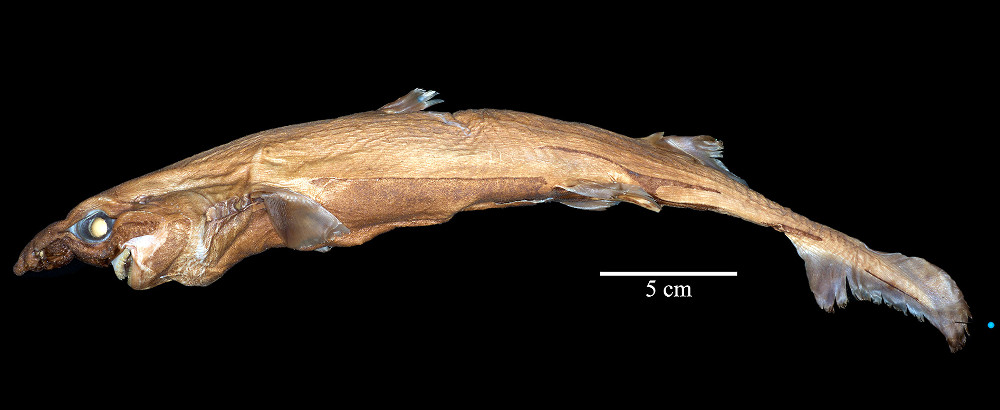Etmopterus lailae
Ebert, Papastamatiou, Kajiura & Wetherbee, 2017
Classification: Elasmobranchii Squaliformes Etmopteridae
Reference of the original description
Etmopterus lailae sp. nov., a new lanternshark (Squaliformes: Etmopteridae) from the Northwestern Hawaiian Islands. Zootaxa, 4237(2), 371–382
Etmopterus lailae sp. nov., a new lanternshark (Squaliformes: Etmopteridae) from the Northwestern Hawaiian Islands. Zootaxa, 4237(2), 371–382
Description :
Citation: Etmopterus lailae Ebert, Papastamatiou, Kajiura & Wetherbee, 2017: In: Database of modern sharks, rays and chimaeras, www.shark-references.com, World Wide Web electronic publication, Version 01/2026
Please send your images of "Etmopterus lailae" to info@shark-references.com

Etmopterus lailae Ebert, Papastamatiou, Kajiura & Wetherbee, 2017; immature male holotype (BPBM 40183)© David Ebert, Pacific Shark Research Center, Moss Landing Marine Laboratories, USA

Etmopterus lailae Ebert, Papastamatiou, Kajiura & Wetherbee, 2017; immature male holotype (BPBM 40183)© David Ebert, Pacific Shark Research Center, Moss Landing Marine Laboratories, USA
Common names
 Laila’s Lanternshark
Laila’s Lanternshark
 Laila’s Lanternshark
Laila’s Lanternshark
Short Description
Original Diagnosis of EBERT, PAPASTAMATIOU, KAJIURA & WETHERBEE, 2017 [25121]: Etmopterus lailae is a moderately large, slender species of linear–denticled Etmopterus that can be separated from most of its congeners within the E. lucifer clade by the length of its anterior flank marking branch being much longer relative to its posterior branch; all other members of this genus, except for two species, have a posterior branch that is equal to or longer than the anterior branch. The only two species with an anterior branch relatively longer than the posterior branch, E. lucifer Jordan & Snyder, 1902 and E. sculptus Ebert, Compagno, & De Vries, 2011, can be separated from the new species by a lower spiral valve count (8–9 vs 14–16 for E. lailae), a slightly higher precaudal vertebral count (55–64 vs 53–57), and a higher number of teeth on the lower jaw (30–43 vs 26–28). Etmopterus lailae lacks dermal denticles between the nostrils on the ventral snout surface and on the dorsal fins, while the other two species have denticles present on the snout and dorsal fins.
Original Diagnosis of EBERT, PAPASTAMATIOU, KAJIURA & WETHERBEE, 2017 [25121]: Etmopterus lailae is a moderately large, slender species of linear–denticled Etmopterus that can be separated from most of its congeners within the E. lucifer clade by the length of its anterior flank marking branch being much longer relative to its posterior branch; all other members of this genus, except for two species, have a posterior branch that is equal to or longer than the anterior branch. The only two species with an anterior branch relatively longer than the posterior branch, E. lucifer Jordan & Snyder, 1902 and E. sculptus Ebert, Compagno, & De Vries, 2011, can be separated from the new species by a lower spiral valve count (8–9 vs 14–16 for E. lailae), a slightly higher precaudal vertebral count (55–64 vs 53–57), and a higher number of teeth on the lower jaw (30–43 vs 26–28). Etmopterus lailae lacks dermal denticles between the nostrils on the ventral snout surface and on the dorsal fins, while the other two species have denticles present on the snout and dorsal fins.
Distribution
Koko and South Kanmu seamounts, Northwestern Hawaiian Islands [25121] Source: www.gbif.org
Koko and South Kanmu seamounts, Northwestern Hawaiian Islands [25121] Source: www.gbif.org
Dentition
Teeth dissimilar in upper and lower jaw; upper jaw teeth with strong central cusp flanked on each side by two smaller lateral cusplets, less than one-half the height of median cusp, and decreasing in size distally; lower jaw teeth unicuspid, blade-like, oblique, fused into a single row. Tooth count in first row of upper jaw 24 (22–24) and in first row of lower jaw 28 (26–26) [25121]
Teeth dissimilar in upper and lower jaw; upper jaw teeth with strong central cusp flanked on each side by two smaller lateral cusplets, less than one-half the height of median cusp, and decreasing in size distally; lower jaw teeth unicuspid, blade-like, oblique, fused into a single row. Tooth count in first row of upper jaw 24 (22–24) and in first row of lower jaw 28 (26–26) [25121]
Remarks
shark-references Species-ID=14846;
shark-references Species-ID=14846;

















